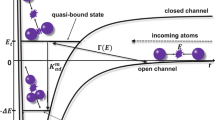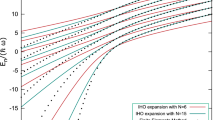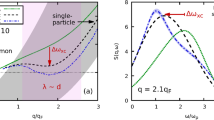Abstract
Experimental studies with cold atoms have advanced our understanding of three-body physics, historically a fundamental yet challenging problem. This is because atomic interactions can be precisely varied in strength using magnetically tunable scattering resonances known as Feshbach resonances. Collisions near the unitarity limit, where scattering is maximum, are known to have universal aspects that are independent of short-range chemical details. Away from this limit, many quantum states are expected to be active during a three-body collision, making the collisional observables practically unpredictable. Here we predict three-body ultracold scattering rates by properly building in the pairwise van der Waals interactions plus the multi-spin properties of a tunable Feshbach resonance state characterized by known dimensionless two-body parameters. Numerically solving the Schrödinger equation then quantitatively determines three-atom collisional properties at all interaction strengths without needing adjustable parameters to fit data. Consequently, we can define a new class of van der Waals universality for cold atom three-body phenomena.
This is a preview of subscription content, access via your institution
Access options
Subscribe to this journal
Receive 12 print issues and online access
$209.00 per year
only $17.42 per issue
Buy this article
- Purchase on Springer Link
- Instant access to full article PDF
Prices may be subject to local taxes which are calculated during checkout





Similar content being viewed by others
References
Levine, R. D. Molecular Reaction Dynamics (Cambridge Univ. Press, 2005).
Chin, C., Grimm, R., Julienne, P. & Tiesinga, E. Feshbach resonances in ultracold gases. Rev. Mod. Phys. 82, 1225–1286 (2010).
Kraemer, T. et al. Evidence for Efimov quantum states in an ultracold gas of caesium atoms. Nature 440, 315–318 (2006).
Berninger, M. et al. Universality of the three-body parameter for Efimov states in ultracold cesium. Phys. Rev. Lett. 107, 120401 (2011).
Pollack, S. E., Dries, D. & Hulet, R. G. Universality in three- and four-body bound states of ultracold atoms. Science 326, 1683–1686 (2009).
Gross, N., Shotan, Z., Kokkelmans, S. & Khaykovich, L. Observation of universality in ultracold 7Li three-body recombination. Phys. Rev. Lett. 103, 163202 (2009).
Gross, N., Shotan, Z., Kokkelmans, S. & Khaykovich, L. Nuclear-spinindependent short-range three-body physics in ultracold atoms. Phys. Rev. Lett. 105, 103203 (2010).
Wild, R. J., Makotyn, P., Pino, J. M., Cornell, E. A. & Jin, D. S. Measurements of Tan’s contact in an atomic Bose–Einstein condensate. Phys. Rev. Lett. 108, 145305 (2012).
Braaten, E. & Hammer, H. W. Universality in few-body systems with large scattering length. Phys. Rep. 428, 259–390 (2006).
Wang, Y., DIncao, J. P. & Esry, B. D. Ultracold few-body systems. Adv. At. Mol. Opt. Phys. 62, 1–115 (2013).
Efimov, V. Energy levels of three resonantly interacting particles. Nucl. Phys. A 210, 157–188 (1973).
Delves, L. Tertiary and general-order collisions. Nucl. Phys. 9, 391–399 (1959).
Efimov, V. Energy levels arising from resonant two-body forces in a three-body system. Phys. Lett. B 33, 563–564 (1970).
Thomas, L. H. The interaction between a neutron and a proton and the structure of H3. Phys. Rev. 47, 903–909 (1935).
Knoop, S. et al. Observation of an Efimov-like trimer resonance in ultracold atom-dimer scattering. Nature Phys. 5, 227–230 (2009).
Roy, S. et al. Test of the universality of the three-body Efimov parameter at narrow Feshbach resonances. Phys. Rev. Lett. 111, 053202 (2013).
Massignan, P. & Stoof, H. T. Efimov states near a Feshbach resonance. Phys. Rev. A 78, 030701 (2008).
Jona-Lasinio, M. & Pricoupenko, L. Three resonant ultracold bosons: Off-resonance effects. Phys. Rev. Lett. 104, 023201 (2010).
Pricoupenko, L. Crossover in the Efimov spectrum. Phys. Rev. A 82, 043633 (2010).
Sørensen, P., Fedorov, D., Jensen, A. & Zinner, N. T. Efimov physics and the three-body parameter within a two-channel framework. Phys. Rev. A 86, 052516 (2012).
Sørensen, P. K., Fedorov, D., Jensen, A. & Zinner, N. T. Finite-range effects in energies and recombination rates of three identical bosons. J. Phys. B 46, 075301 (2013).
Zinner, N. Efimov trimers near the zero-crossing of a Feshbach resonance. Few-Body Syst. 54, 597–603 (2013).
Chin, C. Universal scaling of Efimov resonance positions in cold atom systems. Preprint at http://arxiv.org/abs/1111.1484 (2011).
Schmidt, R., Rath, S. & Zwerger, W. Efimov physics beyond universality. Euro. Phys. J. B 85, 1–6 (2012).
Wang, J., D’Incao, J. P., Esry, B. D. & Greene, C. H. Origin of the three-body parameter universality in Efimov physics. Phys. Rev. Lett. 108, 263001 (2012).
Naidon, P., Endo, S. & Ueda, M. Physical origin of the universal three-body parameter in atomic Efimov physics. Preprint at http://arxiv.org/abs/1208.3912 (2012).
Naidon, P., Endo, S. & Ueda, M. Microscopic origin and universality classes of the Efimov three-body parameter. Phys. Rev. Lett. 112, 105301 (2014).
Mies, F. H., Tiesinga, E. & Julienne, P. S. Manipulation of Feshbach resonances in ultracold atomic collisions using time-dependent magnetic fields. Phys. Rev. A 61, 022721 (2000).
Nygaard, N., Schneider, B. I. & Julienne, P. S. Two-channel R-matrix analysis of magnetic-field-induced Feshbach resonances. Phys. Rev. A 73, 042705 (2006).
Jachymski, K. & Julienne, P. S. Analytical model of overlapping Feshbach resonances. Phys. Rev. A 88, 052701 (2013).
Wang, Y. Universal Efimov Physics in Three- and Four-Body Collisions PhD thesis, Kansas State Univ. (2010).
Gribakin, G. F. & Flambaum, V. V. Calculation of the scattering length in atomic collisions using the semiclassical approximation. Phys. Rev. A 48, 546–553 (1993).
Gao, B. Solutions of the Schrödinger equation for an attractive 1/r6 potential. Phys. Rev. A 58, 1728–1734 (1998).
Berninger, M. et al. Feshbach resonances, weakly bound molecular states, and coupled-channel potentials for cesium at high magnetic fields. Phys. Rev. A 87, 032517 (2013).
Yamashita, M., Frederico, T. & Tomio, L. Three-boson recombination at ultralow temperatures. Phys. Lett. A 363, 468–472 (2007).
Braaten, E., Hammer, H-W., Kang, D. & Platter, L. Three-body recombination of identical bosons with a large positive scattering length at nonzero temperature. Phys. Rev. A 78, 043605 (2008).
Lee, M. D., Köhler, T. & Julienne, P. S. Excited Thomas–Efimov levels in ultracold gases. Phys. Rev. A 76, 012720 (2007).
D’Incao, J. P., Greene, C. H. & Esry, B. D. The short-range three-body phase and other issues impacting the observation of Efimov physics in ultracold quantum gases. J. Phys. B 42, 044016 (2009).
Wang, J., D’Incao, J. P., Wang, Y. & Greene, C. H. Universal three-body recombination via resonant d-wave interactions. Phys. Rev. A 86, 062511 (2012).
Huang, B., Sidorenkov, L. A., Grimm, R. & Hutson, J. M. Observation of the second triatomic resonance in Efimov’s scenario. Phys. Rev. Lett. 112, 190401 (2014).
Zenesini, A. et al. Resonant atom-dimer collisions in cesium: Testing universality at positive scattering lengths. Preprint at http://arxiv.org/abs/1406.3443 (2014).
Petrov, D. S. Three-boson problem near a narrow Feshbach resonance. Phys. Rev. Lett. 93, 143201 (2004).
Gogolin, A. O., Mora, C. & Egger, R. Analytical solution of the bosonic three-body problem. Phys. Rev. Lett. 100, 140404 (2008).
Wang, Y., D’Incao, J. P. & Esry, B. D. Ultracold three-body collisions near narrow Feshbach resonances. Phys. Rev. A 83, 042710 (2011).
Ferlaino, F. et al. Efimov resonances in ultracold quantum gases. Few-Body Syst. 51, 113–133 (2011).
Wang, Y., D’Incao, J. P. & Greene, C. H. Universal three-body physics for fermionic dipoles. Phys. Rev. Lett. 107, 233201 (2011).
Wang, Y., Wang, J., D’Incao, J. P. & Greene, C. H. Universal three-body parameter in heteronuclear atomic systems. Phys. Rev. Lett. 109, 243201 (2012).
Tolstikhin, O. I., Watanabe, S. & Matsuzawa, M. ‘Slow’ variable discretization: A novel approach for Hamiltonians allowing adiabatic separation of variables. J. Phys. B 29, L389–L395 (1996).
Kokoouline, V. & Greene, C. H. Unified theoretical treatment of dissociative recombination of D3h triatomic ions: Application to H3+ and D3+. Phys. Rev. A 68, 012703 (2003).
Santra, R. & Cederbaum, L. S. Non-Hermitian electronic theory and applications to clusters. Phys. Rep. 368, 1–117 (2002).
Acknowledgements
The authors acknowledge the support of AFOSR-MURI award FA9550-09-1-0617, partial support from NSF Grant PHY11-25915, and thank C. H. Greene, J. P. D’Incao and J. Wang for discussions on the method and R. Grimm for providing their original data.
Author information
Authors and Affiliations
Contributions
Y.W. and P.S.J. both contributed equally to writing the manuscript. Y.W. planned the project in consultation with P.S.J. and implemented the numerical calculations.
Corresponding author
Ethics declarations
Competing interests
The authors declare no competing financial interests.
Rights and permissions
About this article
Cite this article
Wang, Y., Julienne, P. Universal van der Waals physics for three cold atoms near Feshbach resonances. Nature Phys 10, 768–773 (2014). https://doi.org/10.1038/nphys3071
Received:
Accepted:
Published:
Issue Date:
DOI: https://doi.org/10.1038/nphys3071
This article is cited by
-
Van der Waals five-body size-energy universality
Scientific Reports (2022)
-
Emergence of N-Body Tunable Interactions in Universal Few-Atom Systems
Brazilian Journal of Physics (2021)
-
Universality of size-energy ratio in four-body systems
Scientific Reports (2019)
-
Bound to be universal?
Nature Physics (2015)
-
Efimov Physics with a Finite-Range Parameter
Few-Body Systems (2015)



